Western Sydney Uni: System04104 Leadership Reflective Essay
VerifiedAdded on 2022/10/07
|9
|3242
|38
Essay
AI Summary
This reflective essay, prepared for System04104, explores leadership principles within the context of beginning nursing practice. The author analyzes a case study involving a conflict between a registrar and a new nurse (Kim) during an intubation procedure, applying the Gibbs Reflective Cycle to dissect the situation's description, feelings, evaluation, and analysis. The essay incorporates a 16 Personality Factors test and SWOT analysis to identify the author's leadership strengths (e.g., being a natural-born leader, friendly, patient) and weaknesses (e.g., emotional, trusting). It evaluates the registrar's behavior, highlighting the importance of respectful communication and ethical conduct in nursing, and contrasts this with the positive example set by the NUM. The author reflects on their own leadership approach, emphasizing patience, understanding, and the importance of fostering a supportive environment to motivate others. The conclusion underscores the need for a leader to possess a calm demeanor and to avoid behaviors that could damage the confidence of new learners and potentially affect organizational performance. The essay emphasizes the importance of effective communication, ethical behavior, and self-awareness in nursing leadership.
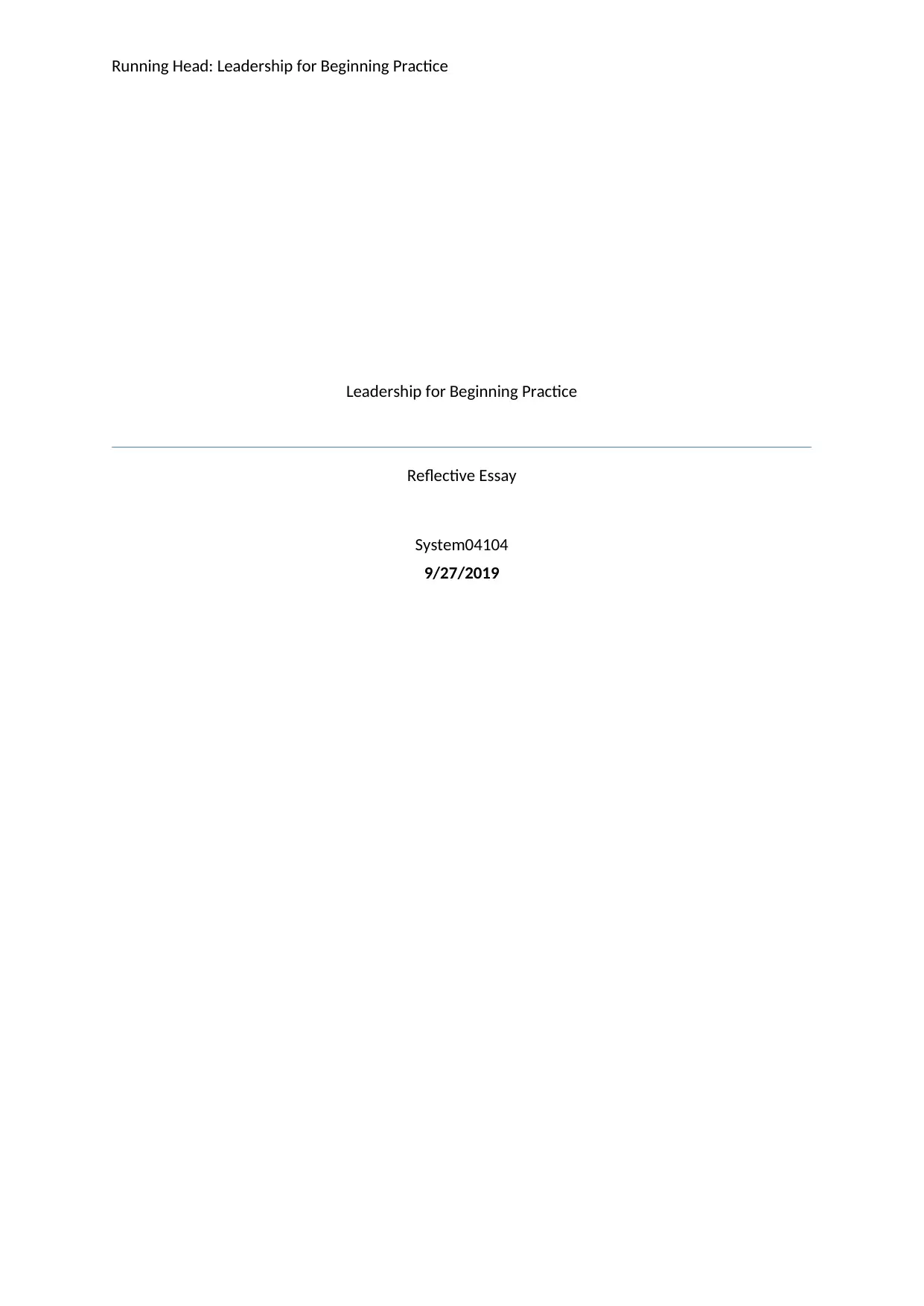
Running Head: Leadership for Beginning Practice
Leadership for Beginning Practice
Reflective Essay
System04104
9/27/2019
Leadership for Beginning Practice
Reflective Essay
System04104
9/27/2019
Paraphrase This Document
Need a fresh take? Get an instant paraphrase of this document with our AI Paraphraser
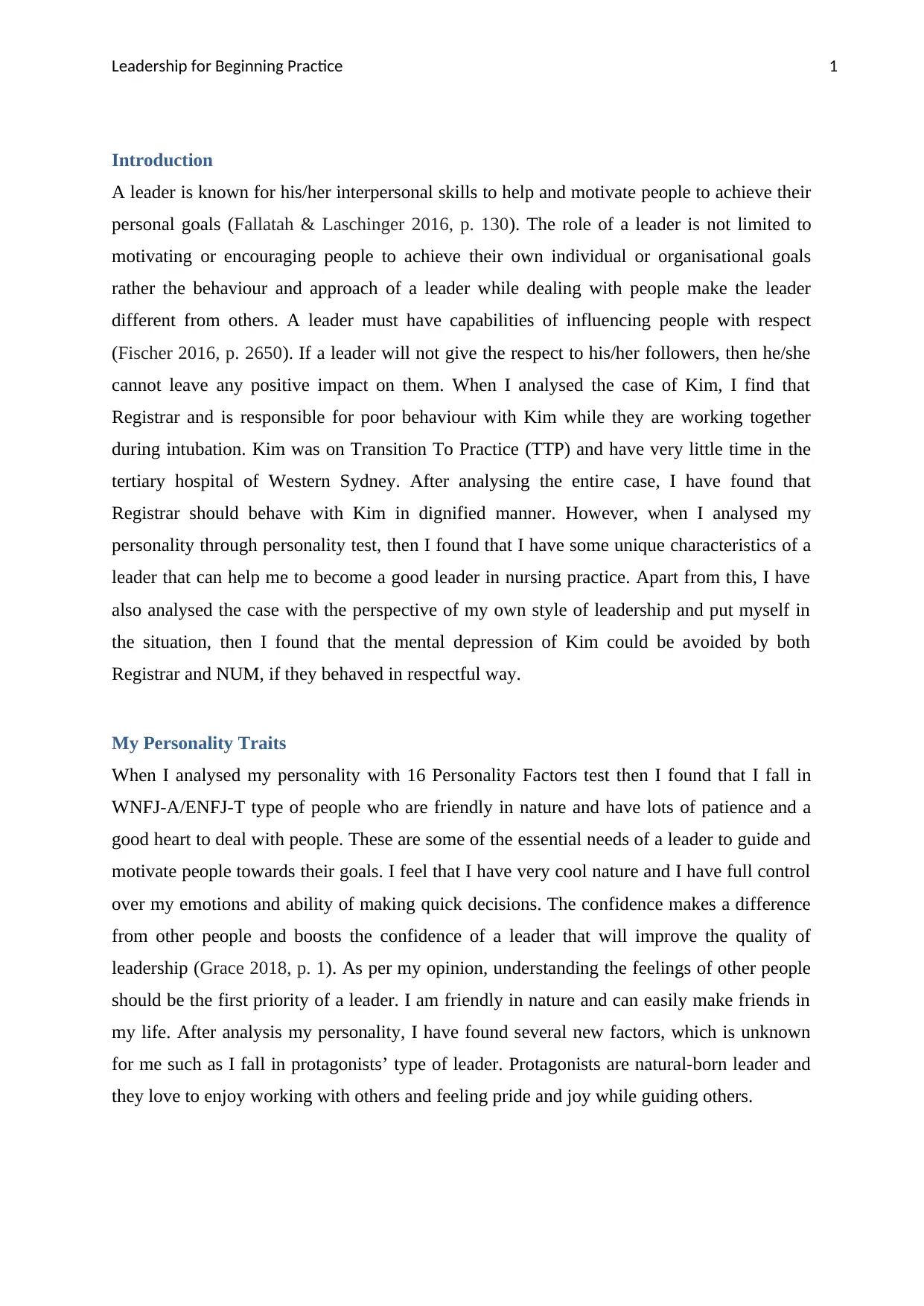
Leadership for Beginning Practice 1
Introduction
A leader is known for his/her interpersonal skills to help and motivate people to achieve their
personal goals (Fallatah & Laschinger 2016, p. 130). The role of a leader is not limited to
motivating or encouraging people to achieve their own individual or organisational goals
rather the behaviour and approach of a leader while dealing with people make the leader
different from others. A leader must have capabilities of influencing people with respect
(Fischer 2016, p. 2650). If a leader will not give the respect to his/her followers, then he/she
cannot leave any positive impact on them. When I analysed the case of Kim, I find that
Registrar and is responsible for poor behaviour with Kim while they are working together
during intubation. Kim was on Transition To Practice (TTP) and have very little time in the
tertiary hospital of Western Sydney. After analysing the entire case, I have found that
Registrar should behave with Kim in dignified manner. However, when I analysed my
personality through personality test, then I found that I have some unique characteristics of a
leader that can help me to become a good leader in nursing practice. Apart from this, I have
also analysed the case with the perspective of my own style of leadership and put myself in
the situation, then I found that the mental depression of Kim could be avoided by both
Registrar and NUM, if they behaved in respectful way.
My Personality Traits
When I analysed my personality with 16 Personality Factors test then I found that I fall in
WNFJ-A/ENFJ-T type of people who are friendly in nature and have lots of patience and a
good heart to deal with people. These are some of the essential needs of a leader to guide and
motivate people towards their goals. I feel that I have very cool nature and I have full control
over my emotions and ability of making quick decisions. The confidence makes a difference
from other people and boosts the confidence of a leader that will improve the quality of
leadership (Grace 2018, p. 1). As per my opinion, understanding the feelings of other people
should be the first priority of a leader. I am friendly in nature and can easily make friends in
my life. After analysis my personality, I have found several new factors, which is unknown
for me such as I fall in protagonists’ type of leader. Protagonists are natural-born leader and
they love to enjoy working with others and feeling pride and joy while guiding others.
Introduction
A leader is known for his/her interpersonal skills to help and motivate people to achieve their
personal goals (Fallatah & Laschinger 2016, p. 130). The role of a leader is not limited to
motivating or encouraging people to achieve their own individual or organisational goals
rather the behaviour and approach of a leader while dealing with people make the leader
different from others. A leader must have capabilities of influencing people with respect
(Fischer 2016, p. 2650). If a leader will not give the respect to his/her followers, then he/she
cannot leave any positive impact on them. When I analysed the case of Kim, I find that
Registrar and is responsible for poor behaviour with Kim while they are working together
during intubation. Kim was on Transition To Practice (TTP) and have very little time in the
tertiary hospital of Western Sydney. After analysing the entire case, I have found that
Registrar should behave with Kim in dignified manner. However, when I analysed my
personality through personality test, then I found that I have some unique characteristics of a
leader that can help me to become a good leader in nursing practice. Apart from this, I have
also analysed the case with the perspective of my own style of leadership and put myself in
the situation, then I found that the mental depression of Kim could be avoided by both
Registrar and NUM, if they behaved in respectful way.
My Personality Traits
When I analysed my personality with 16 Personality Factors test then I found that I fall in
WNFJ-A/ENFJ-T type of people who are friendly in nature and have lots of patience and a
good heart to deal with people. These are some of the essential needs of a leader to guide and
motivate people towards their goals. I feel that I have very cool nature and I have full control
over my emotions and ability of making quick decisions. The confidence makes a difference
from other people and boosts the confidence of a leader that will improve the quality of
leadership (Grace 2018, p. 1). As per my opinion, understanding the feelings of other people
should be the first priority of a leader. I am friendly in nature and can easily make friends in
my life. After analysis my personality, I have found several new factors, which is unknown
for me such as I fall in protagonists’ type of leader. Protagonists are natural-born leader and
they love to enjoy working with others and feeling pride and joy while guiding others.
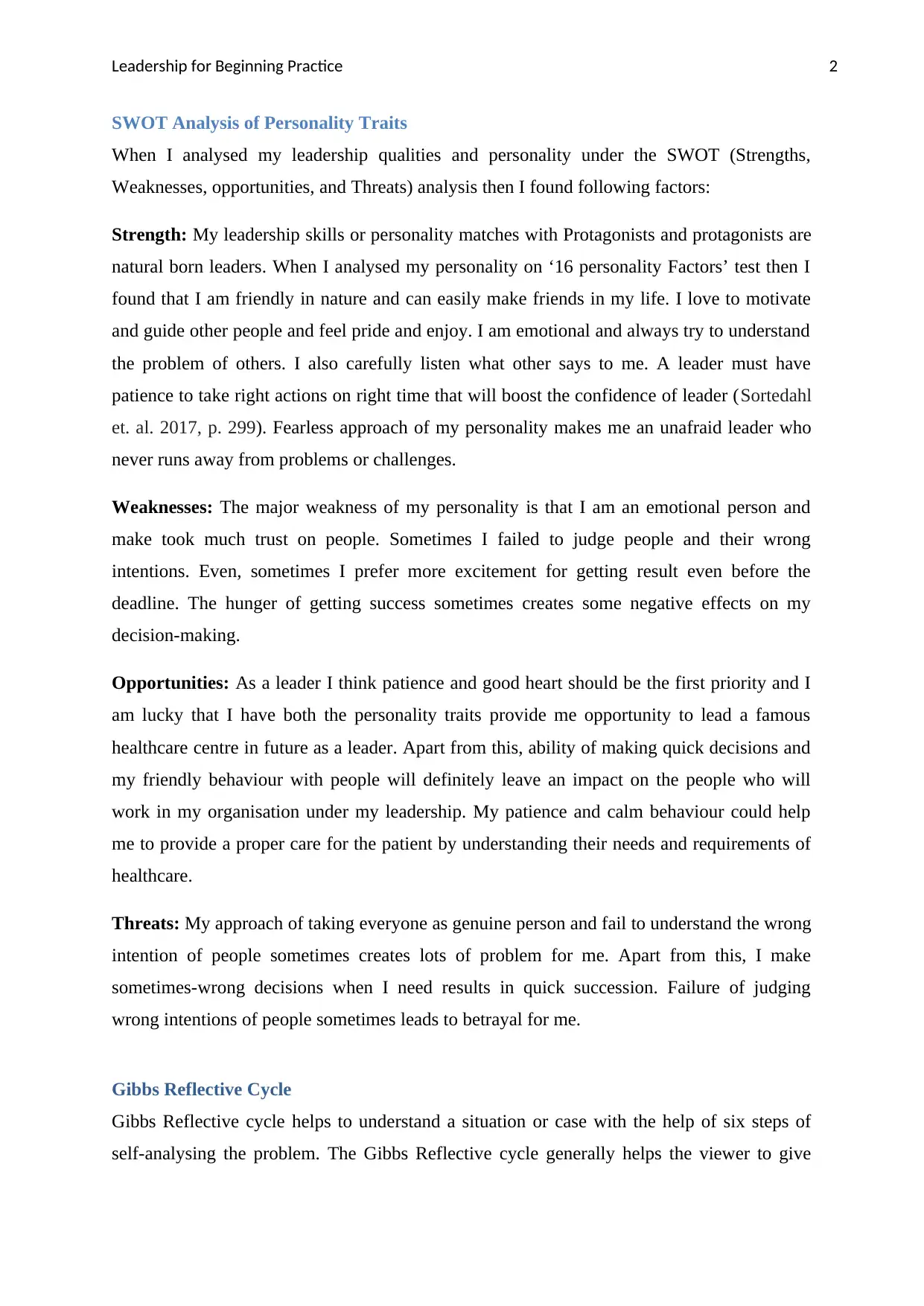
Leadership for Beginning Practice 2
SWOT Analysis of Personality Traits
When I analysed my leadership qualities and personality under the SWOT (Strengths,
Weaknesses, opportunities, and Threats) analysis then I found following factors:
Strength: My leadership skills or personality matches with Protagonists and protagonists are
natural born leaders. When I analysed my personality on ‘16 personality Factors’ test then I
found that I am friendly in nature and can easily make friends in my life. I love to motivate
and guide other people and feel pride and enjoy. I am emotional and always try to understand
the problem of others. I also carefully listen what other says to me. A leader must have
patience to take right actions on right time that will boost the confidence of leader (Sortedahl
et. al. 2017, p. 299). Fearless approach of my personality makes me an unafraid leader who
never runs away from problems or challenges.
Weaknesses: The major weakness of my personality is that I am an emotional person and
make took much trust on people. Sometimes I failed to judge people and their wrong
intentions. Even, sometimes I prefer more excitement for getting result even before the
deadline. The hunger of getting success sometimes creates some negative effects on my
decision-making.
Opportunities: As a leader I think patience and good heart should be the first priority and I
am lucky that I have both the personality traits provide me opportunity to lead a famous
healthcare centre in future as a leader. Apart from this, ability of making quick decisions and
my friendly behaviour with people will definitely leave an impact on the people who will
work in my organisation under my leadership. My patience and calm behaviour could help
me to provide a proper care for the patient by understanding their needs and requirements of
healthcare.
Threats: My approach of taking everyone as genuine person and fail to understand the wrong
intention of people sometimes creates lots of problem for me. Apart from this, I make
sometimes-wrong decisions when I need results in quick succession. Failure of judging
wrong intentions of people sometimes leads to betrayal for me.
Gibbs Reflective Cycle
Gibbs Reflective cycle helps to understand a situation or case with the help of six steps of
self-analysing the problem. The Gibbs Reflective cycle generally helps the viewer to give
SWOT Analysis of Personality Traits
When I analysed my leadership qualities and personality under the SWOT (Strengths,
Weaknesses, opportunities, and Threats) analysis then I found following factors:
Strength: My leadership skills or personality matches with Protagonists and protagonists are
natural born leaders. When I analysed my personality on ‘16 personality Factors’ test then I
found that I am friendly in nature and can easily make friends in my life. I love to motivate
and guide other people and feel pride and enjoy. I am emotional and always try to understand
the problem of others. I also carefully listen what other says to me. A leader must have
patience to take right actions on right time that will boost the confidence of leader (Sortedahl
et. al. 2017, p. 299). Fearless approach of my personality makes me an unafraid leader who
never runs away from problems or challenges.
Weaknesses: The major weakness of my personality is that I am an emotional person and
make took much trust on people. Sometimes I failed to judge people and their wrong
intentions. Even, sometimes I prefer more excitement for getting result even before the
deadline. The hunger of getting success sometimes creates some negative effects on my
decision-making.
Opportunities: As a leader I think patience and good heart should be the first priority and I
am lucky that I have both the personality traits provide me opportunity to lead a famous
healthcare centre in future as a leader. Apart from this, ability of making quick decisions and
my friendly behaviour with people will definitely leave an impact on the people who will
work in my organisation under my leadership. My patience and calm behaviour could help
me to provide a proper care for the patient by understanding their needs and requirements of
healthcare.
Threats: My approach of taking everyone as genuine person and fail to understand the wrong
intention of people sometimes creates lots of problem for me. Apart from this, I make
sometimes-wrong decisions when I need results in quick succession. Failure of judging
wrong intentions of people sometimes leads to betrayal for me.
Gibbs Reflective Cycle
Gibbs Reflective cycle helps to understand a situation or case with the help of six steps of
self-analysing the problem. The Gibbs Reflective cycle generally helps the viewer to give
⊘ This is a preview!⊘
Do you want full access?
Subscribe today to unlock all pages.

Trusted by 1+ million students worldwide
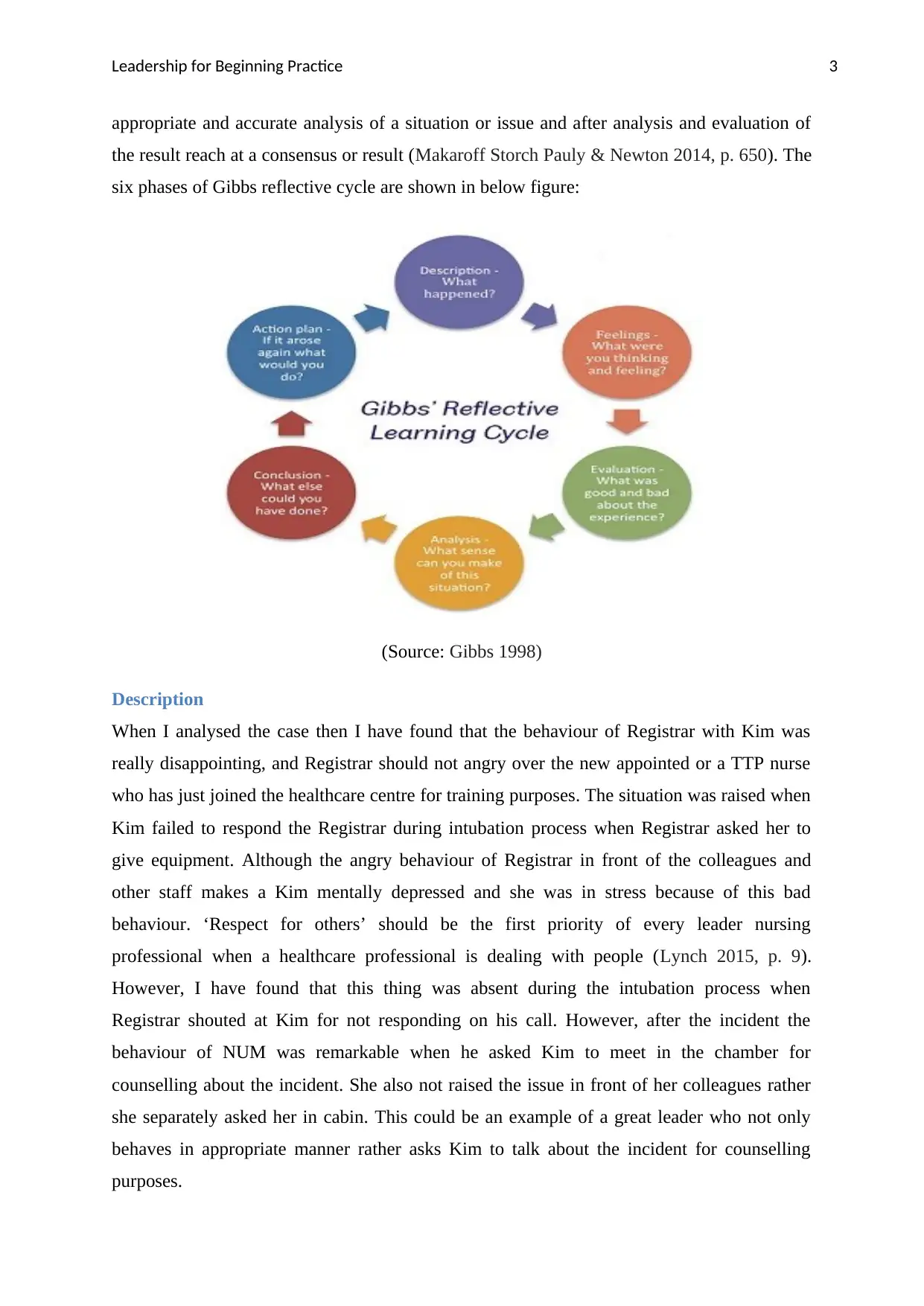
Leadership for Beginning Practice 3
appropriate and accurate analysis of a situation or issue and after analysis and evaluation of
the result reach at a consensus or result (Makaroff Storch Pauly & Newton 2014, p. 650). The
six phases of Gibbs reflective cycle are shown in below figure:
(Source: Gibbs 1998)
Description
When I analysed the case then I have found that the behaviour of Registrar with Kim was
really disappointing, and Registrar should not angry over the new appointed or a TTP nurse
who has just joined the healthcare centre for training purposes. The situation was raised when
Kim failed to respond the Registrar during intubation process when Registrar asked her to
give equipment. Although the angry behaviour of Registrar in front of the colleagues and
other staff makes a Kim mentally depressed and she was in stress because of this bad
behaviour. ‘Respect for others’ should be the first priority of every leader nursing
professional when a healthcare professional is dealing with people (Lynch 2015, p. 9).
However, I have found that this thing was absent during the intubation process when
Registrar shouted at Kim for not responding on his call. However, after the incident the
behaviour of NUM was remarkable when he asked Kim to meet in the chamber for
counselling about the incident. She also not raised the issue in front of her colleagues rather
she separately asked her in cabin. This could be an example of a great leader who not only
behaves in appropriate manner rather asks Kim to talk about the incident for counselling
purposes.
appropriate and accurate analysis of a situation or issue and after analysis and evaluation of
the result reach at a consensus or result (Makaroff Storch Pauly & Newton 2014, p. 650). The
six phases of Gibbs reflective cycle are shown in below figure:
(Source: Gibbs 1998)
Description
When I analysed the case then I have found that the behaviour of Registrar with Kim was
really disappointing, and Registrar should not angry over the new appointed or a TTP nurse
who has just joined the healthcare centre for training purposes. The situation was raised when
Kim failed to respond the Registrar during intubation process when Registrar asked her to
give equipment. Although the angry behaviour of Registrar in front of the colleagues and
other staff makes a Kim mentally depressed and she was in stress because of this bad
behaviour. ‘Respect for others’ should be the first priority of every leader nursing
professional when a healthcare professional is dealing with people (Lynch 2015, p. 9).
However, I have found that this thing was absent during the intubation process when
Registrar shouted at Kim for not responding on his call. However, after the incident the
behaviour of NUM was remarkable when he asked Kim to meet in the chamber for
counselling about the incident. She also not raised the issue in front of her colleagues rather
she separately asked her in cabin. This could be an example of a great leader who not only
behaves in appropriate manner rather asks Kim to talk about the incident for counselling
purposes.
Paraphrase This Document
Need a fresh take? Get an instant paraphrase of this document with our AI Paraphraser
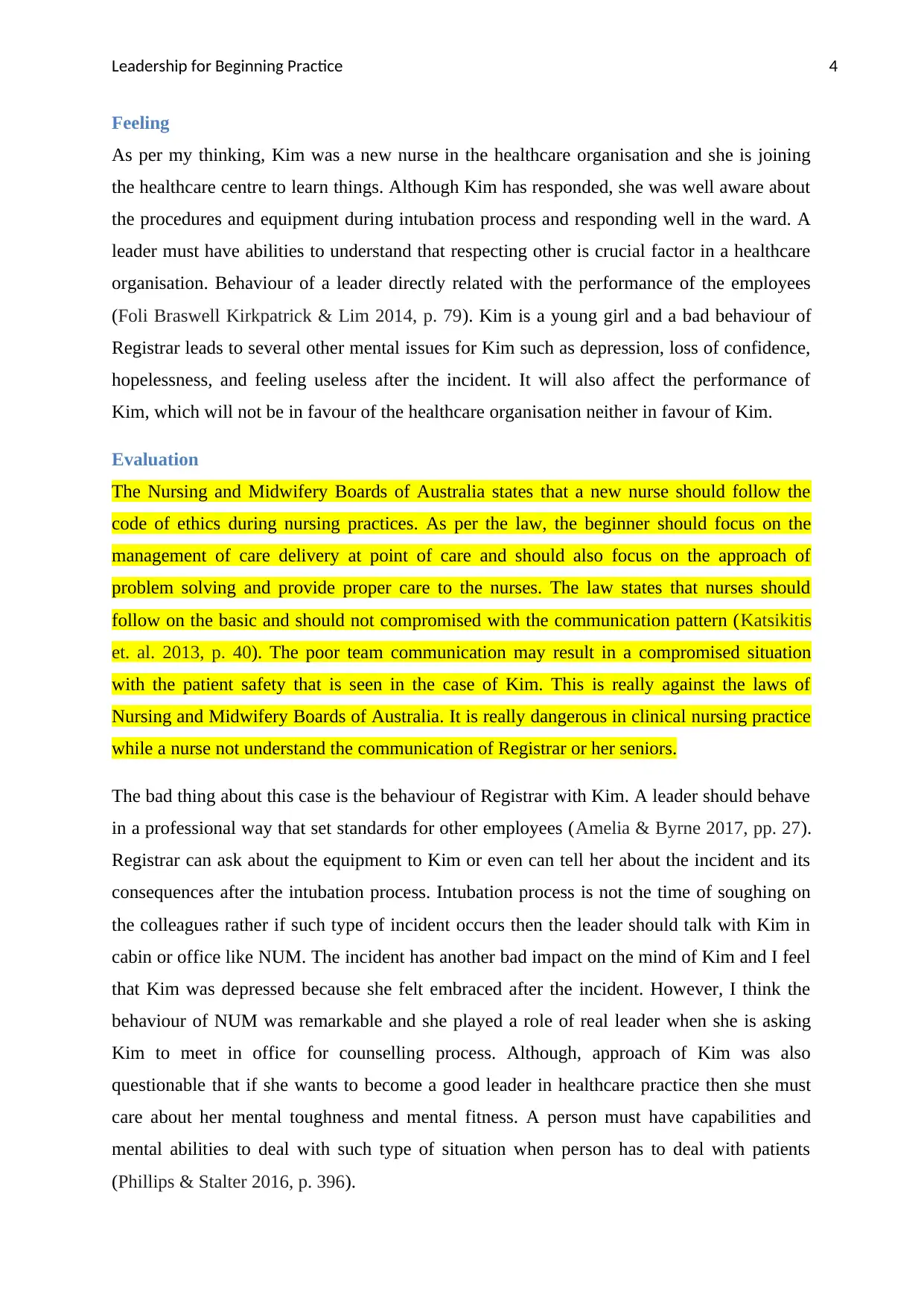
Leadership for Beginning Practice 4
Feeling
As per my thinking, Kim was a new nurse in the healthcare organisation and she is joining
the healthcare centre to learn things. Although Kim has responded, she was well aware about
the procedures and equipment during intubation process and responding well in the ward. A
leader must have abilities to understand that respecting other is crucial factor in a healthcare
organisation. Behaviour of a leader directly related with the performance of the employees
(Foli Braswell Kirkpatrick & Lim 2014, p. 79). Kim is a young girl and a bad behaviour of
Registrar leads to several other mental issues for Kim such as depression, loss of confidence,
hopelessness, and feeling useless after the incident. It will also affect the performance of
Kim, which will not be in favour of the healthcare organisation neither in favour of Kim.
Evaluation
The Nursing and Midwifery Boards of Australia states that a new nurse should follow the
code of ethics during nursing practices. As per the law, the beginner should focus on the
management of care delivery at point of care and should also focus on the approach of
problem solving and provide proper care to the nurses. The law states that nurses should
follow on the basic and should not compromised with the communication pattern (Katsikitis
et. al. 2013, p. 40). The poor team communication may result in a compromised situation
with the patient safety that is seen in the case of Kim. This is really against the laws of
Nursing and Midwifery Boards of Australia. It is really dangerous in clinical nursing practice
while a nurse not understand the communication of Registrar or her seniors.
The bad thing about this case is the behaviour of Registrar with Kim. A leader should behave
in a professional way that set standards for other employees (Amelia & Byrne 2017, pp. 27).
Registrar can ask about the equipment to Kim or even can tell her about the incident and its
consequences after the intubation process. Intubation process is not the time of soughing on
the colleagues rather if such type of incident occurs then the leader should talk with Kim in
cabin or office like NUM. The incident has another bad impact on the mind of Kim and I feel
that Kim was depressed because she felt embraced after the incident. However, I think the
behaviour of NUM was remarkable and she played a role of real leader when she is asking
Kim to meet in office for counselling process. Although, approach of Kim was also
questionable that if she wants to become a good leader in healthcare practice then she must
care about her mental toughness and mental fitness. A person must have capabilities and
mental abilities to deal with such type of situation when person has to deal with patients
(Phillips & Stalter 2016, p. 396).
Feeling
As per my thinking, Kim was a new nurse in the healthcare organisation and she is joining
the healthcare centre to learn things. Although Kim has responded, she was well aware about
the procedures and equipment during intubation process and responding well in the ward. A
leader must have abilities to understand that respecting other is crucial factor in a healthcare
organisation. Behaviour of a leader directly related with the performance of the employees
(Foli Braswell Kirkpatrick & Lim 2014, p. 79). Kim is a young girl and a bad behaviour of
Registrar leads to several other mental issues for Kim such as depression, loss of confidence,
hopelessness, and feeling useless after the incident. It will also affect the performance of
Kim, which will not be in favour of the healthcare organisation neither in favour of Kim.
Evaluation
The Nursing and Midwifery Boards of Australia states that a new nurse should follow the
code of ethics during nursing practices. As per the law, the beginner should focus on the
management of care delivery at point of care and should also focus on the approach of
problem solving and provide proper care to the nurses. The law states that nurses should
follow on the basic and should not compromised with the communication pattern (Katsikitis
et. al. 2013, p. 40). The poor team communication may result in a compromised situation
with the patient safety that is seen in the case of Kim. This is really against the laws of
Nursing and Midwifery Boards of Australia. It is really dangerous in clinical nursing practice
while a nurse not understand the communication of Registrar or her seniors.
The bad thing about this case is the behaviour of Registrar with Kim. A leader should behave
in a professional way that set standards for other employees (Amelia & Byrne 2017, pp. 27).
Registrar can ask about the equipment to Kim or even can tell her about the incident and its
consequences after the intubation process. Intubation process is not the time of soughing on
the colleagues rather if such type of incident occurs then the leader should talk with Kim in
cabin or office like NUM. The incident has another bad impact on the mind of Kim and I feel
that Kim was depressed because she felt embraced after the incident. However, I think the
behaviour of NUM was remarkable and she played a role of real leader when she is asking
Kim to meet in office for counselling process. Although, approach of Kim was also
questionable that if she wants to become a good leader in healthcare practice then she must
care about her mental toughness and mental fitness. A person must have capabilities and
mental abilities to deal with such type of situation when person has to deal with patients
(Phillips & Stalter 2016, p. 396).
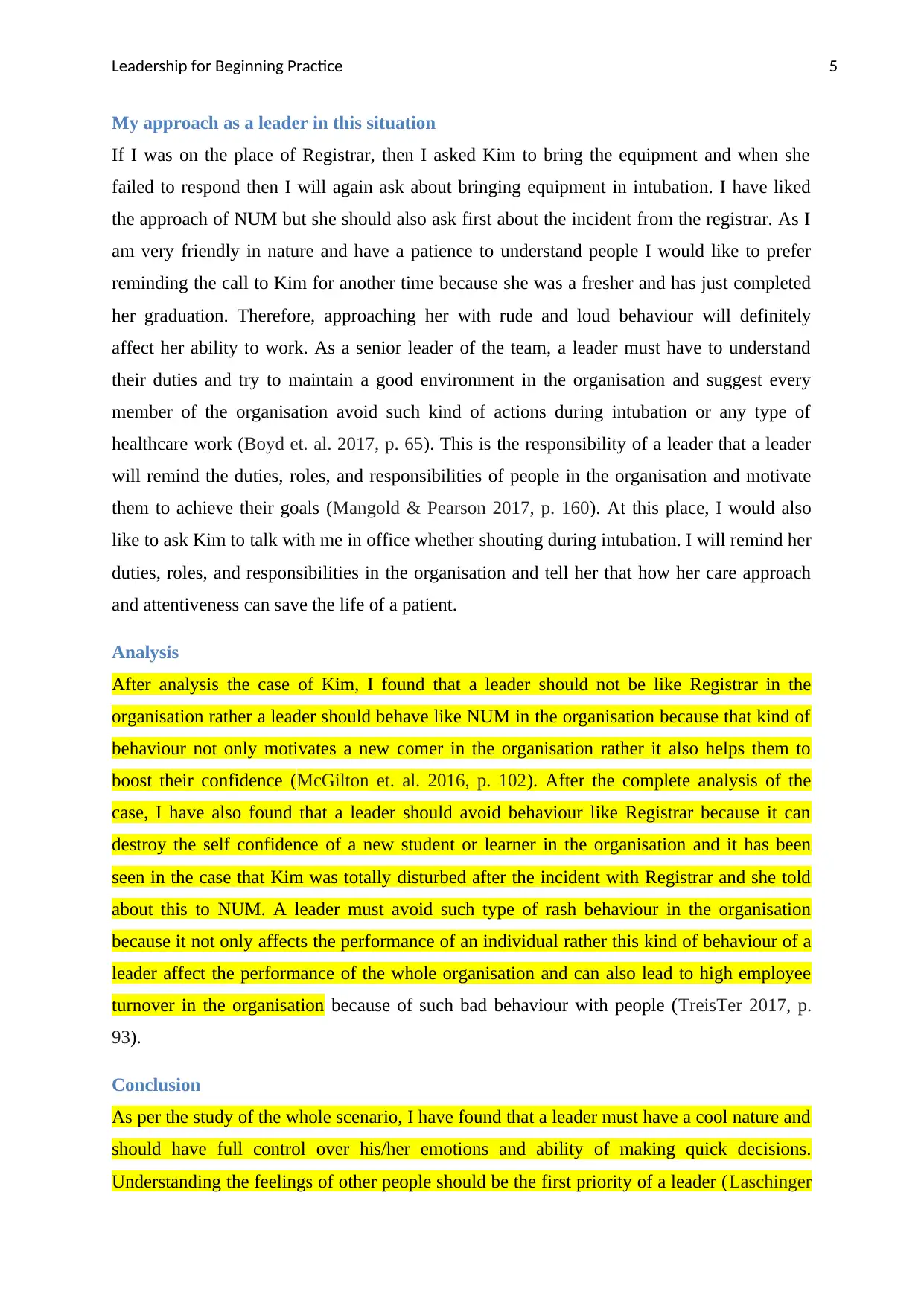
Leadership for Beginning Practice 5
My approach as a leader in this situation
If I was on the place of Registrar, then I asked Kim to bring the equipment and when she
failed to respond then I will again ask about bringing equipment in intubation. I have liked
the approach of NUM but she should also ask first about the incident from the registrar. As I
am very friendly in nature and have a patience to understand people I would like to prefer
reminding the call to Kim for another time because she was a fresher and has just completed
her graduation. Therefore, approaching her with rude and loud behaviour will definitely
affect her ability to work. As a senior leader of the team, a leader must have to understand
their duties and try to maintain a good environment in the organisation and suggest every
member of the organisation avoid such kind of actions during intubation or any type of
healthcare work (Boyd et. al. 2017, p. 65). This is the responsibility of a leader that a leader
will remind the duties, roles, and responsibilities of people in the organisation and motivate
them to achieve their goals (Mangold & Pearson 2017, p. 160). At this place, I would also
like to ask Kim to talk with me in office whether shouting during intubation. I will remind her
duties, roles, and responsibilities in the organisation and tell her that how her care approach
and attentiveness can save the life of a patient.
Analysis
After analysis the case of Kim, I found that a leader should not be like Registrar in the
organisation rather a leader should behave like NUM in the organisation because that kind of
behaviour not only motivates a new comer in the organisation rather it also helps them to
boost their confidence (McGilton et. al. 2016, p. 102). After the complete analysis of the
case, I have also found that a leader should avoid behaviour like Registrar because it can
destroy the self confidence of a new student or learner in the organisation and it has been
seen in the case that Kim was totally disturbed after the incident with Registrar and she told
about this to NUM. A leader must avoid such type of rash behaviour in the organisation
because it not only affects the performance of an individual rather this kind of behaviour of a
leader affect the performance of the whole organisation and can also lead to high employee
turnover in the organisation because of such bad behaviour with people (TreisTer 2017, p.
93).
Conclusion
As per the study of the whole scenario, I have found that a leader must have a cool nature and
should have full control over his/her emotions and ability of making quick decisions.
Understanding the feelings of other people should be the first priority of a leader (Laschinger
My approach as a leader in this situation
If I was on the place of Registrar, then I asked Kim to bring the equipment and when she
failed to respond then I will again ask about bringing equipment in intubation. I have liked
the approach of NUM but she should also ask first about the incident from the registrar. As I
am very friendly in nature and have a patience to understand people I would like to prefer
reminding the call to Kim for another time because she was a fresher and has just completed
her graduation. Therefore, approaching her with rude and loud behaviour will definitely
affect her ability to work. As a senior leader of the team, a leader must have to understand
their duties and try to maintain a good environment in the organisation and suggest every
member of the organisation avoid such kind of actions during intubation or any type of
healthcare work (Boyd et. al. 2017, p. 65). This is the responsibility of a leader that a leader
will remind the duties, roles, and responsibilities of people in the organisation and motivate
them to achieve their goals (Mangold & Pearson 2017, p. 160). At this place, I would also
like to ask Kim to talk with me in office whether shouting during intubation. I will remind her
duties, roles, and responsibilities in the organisation and tell her that how her care approach
and attentiveness can save the life of a patient.
Analysis
After analysis the case of Kim, I found that a leader should not be like Registrar in the
organisation rather a leader should behave like NUM in the organisation because that kind of
behaviour not only motivates a new comer in the organisation rather it also helps them to
boost their confidence (McGilton et. al. 2016, p. 102). After the complete analysis of the
case, I have also found that a leader should avoid behaviour like Registrar because it can
destroy the self confidence of a new student or learner in the organisation and it has been
seen in the case that Kim was totally disturbed after the incident with Registrar and she told
about this to NUM. A leader must avoid such type of rash behaviour in the organisation
because it not only affects the performance of an individual rather this kind of behaviour of a
leader affect the performance of the whole organisation and can also lead to high employee
turnover in the organisation because of such bad behaviour with people (TreisTer 2017, p.
93).
Conclusion
As per the study of the whole scenario, I have found that a leader must have a cool nature and
should have full control over his/her emotions and ability of making quick decisions.
Understanding the feelings of other people should be the first priority of a leader (Laschinger
⊘ This is a preview!⊘
Do you want full access?
Subscribe today to unlock all pages.

Trusted by 1+ million students worldwide
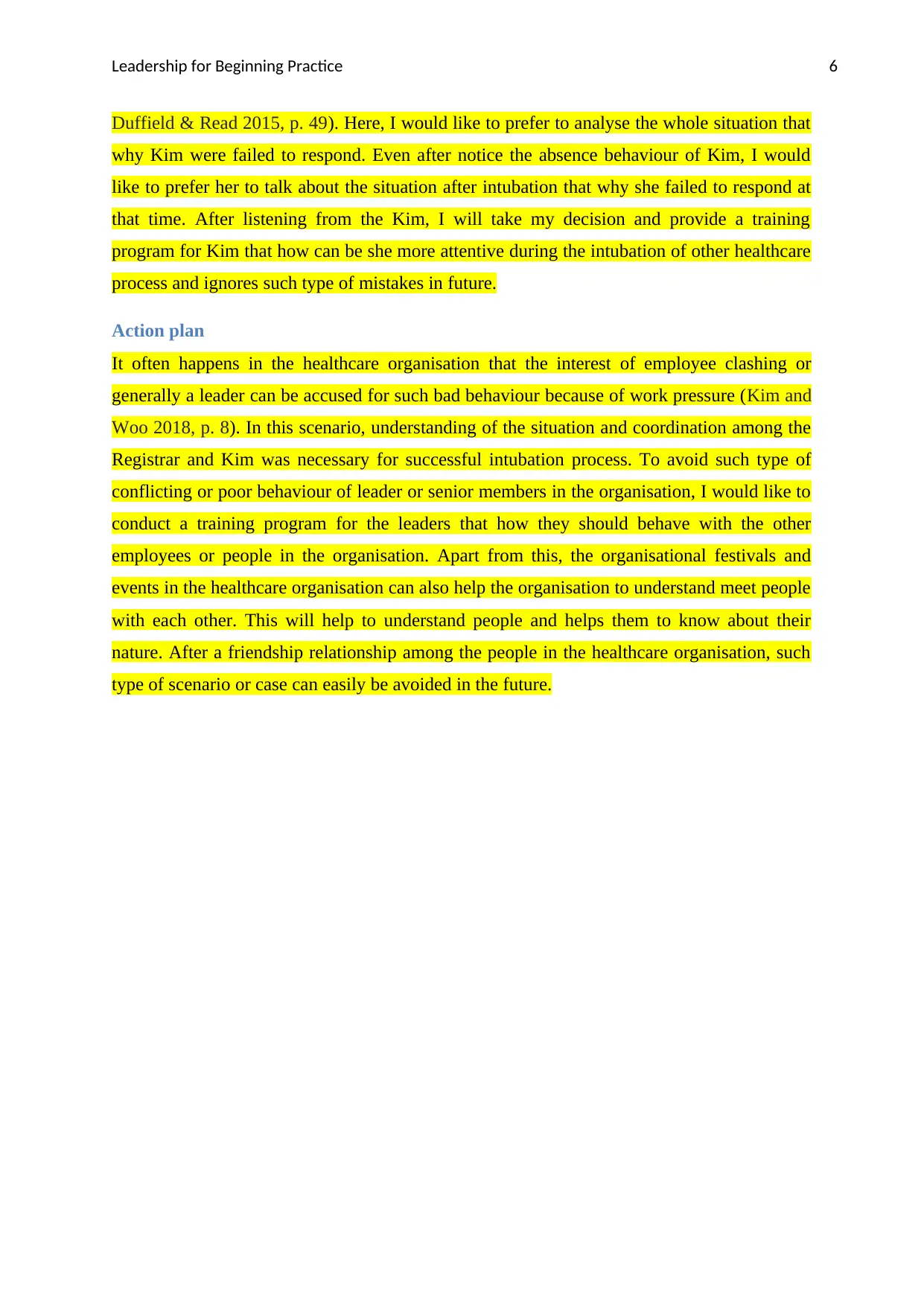
Leadership for Beginning Practice 6
Duffield & Read 2015, p. 49). Here, I would like to prefer to analyse the whole situation that
why Kim were failed to respond. Even after notice the absence behaviour of Kim, I would
like to prefer her to talk about the situation after intubation that why she failed to respond at
that time. After listening from the Kim, I will take my decision and provide a training
program for Kim that how can be she more attentive during the intubation of other healthcare
process and ignores such type of mistakes in future.
Action plan
It often happens in the healthcare organisation that the interest of employee clashing or
generally a leader can be accused for such bad behaviour because of work pressure (Kim and
Woo 2018, p. 8). In this scenario, understanding of the situation and coordination among the
Registrar and Kim was necessary for successful intubation process. To avoid such type of
conflicting or poor behaviour of leader or senior members in the organisation, I would like to
conduct a training program for the leaders that how they should behave with the other
employees or people in the organisation. Apart from this, the organisational festivals and
events in the healthcare organisation can also help the organisation to understand meet people
with each other. This will help to understand people and helps them to know about their
nature. After a friendship relationship among the people in the healthcare organisation, such
type of scenario or case can easily be avoided in the future.
Duffield & Read 2015, p. 49). Here, I would like to prefer to analyse the whole situation that
why Kim were failed to respond. Even after notice the absence behaviour of Kim, I would
like to prefer her to talk about the situation after intubation that why she failed to respond at
that time. After listening from the Kim, I will take my decision and provide a training
program for Kim that how can be she more attentive during the intubation of other healthcare
process and ignores such type of mistakes in future.
Action plan
It often happens in the healthcare organisation that the interest of employee clashing or
generally a leader can be accused for such bad behaviour because of work pressure (Kim and
Woo 2018, p. 8). In this scenario, understanding of the situation and coordination among the
Registrar and Kim was necessary for successful intubation process. To avoid such type of
conflicting or poor behaviour of leader or senior members in the organisation, I would like to
conduct a training program for the leaders that how they should behave with the other
employees or people in the organisation. Apart from this, the organisational festivals and
events in the healthcare organisation can also help the organisation to understand meet people
with each other. This will help to understand people and helps them to know about their
nature. After a friendship relationship among the people in the healthcare organisation, such
type of scenario or case can easily be avoided in the future.
Paraphrase This Document
Need a fresh take? Get an instant paraphrase of this document with our AI Paraphraser
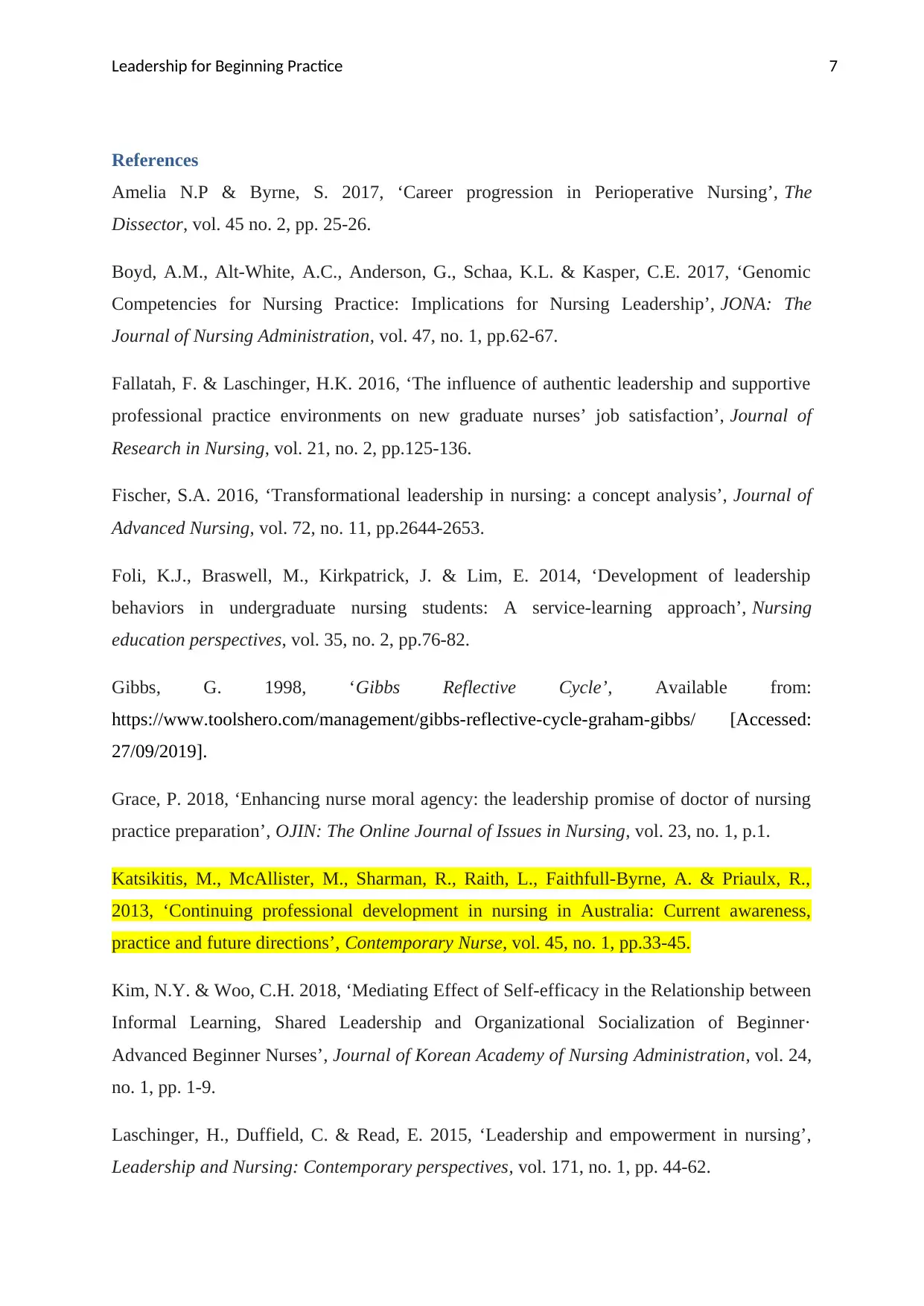
Leadership for Beginning Practice 7
References
Amelia N.P & Byrne, S. 2017, ‘Career progression in Perioperative Nursing’, The
Dissector, vol. 45 no. 2, pp. 25-26.
Boyd, A.M., Alt-White, A.C., Anderson, G., Schaa, K.L. & Kasper, C.E. 2017, ‘Genomic
Competencies for Nursing Practice: Implications for Nursing Leadership’, JONA: The
Journal of Nursing Administration, vol. 47, no. 1, pp.62-67.
Fallatah, F. & Laschinger, H.K. 2016, ‘The influence of authentic leadership and supportive
professional practice environments on new graduate nurses’ job satisfaction’, Journal of
Research in Nursing, vol. 21, no. 2, pp.125-136.
Fischer, S.A. 2016, ‘Transformational leadership in nursing: a concept analysis’, Journal of
Advanced Nursing, vol. 72, no. 11, pp.2644-2653.
Foli, K.J., Braswell, M., Kirkpatrick, J. & Lim, E. 2014, ‘Development of leadership
behaviors in undergraduate nursing students: A service-learning approach’, Nursing
education perspectives, vol. 35, no. 2, pp.76-82.
Gibbs, G. 1998, ‘Gibbs Reflective Cycle’, Available from:
https://www.toolshero.com/management/gibbs-reflective-cycle-graham-gibbs/ [Accessed:
27/09/2019].
Grace, P. 2018, ‘Enhancing nurse moral agency: the leadership promise of doctor of nursing
practice preparation’, OJIN: The Online Journal of Issues in Nursing, vol. 23, no. 1, p.1.
Katsikitis, M., McAllister, M., Sharman, R., Raith, L., Faithfull-Byrne, A. & Priaulx, R.,
2013, ‘Continuing professional development in nursing in Australia: Current awareness,
practice and future directions’, Contemporary Nurse, vol. 45, no. 1, pp.33-45.
Kim, N.Y. & Woo, C.H. 2018, ‘Mediating Effect of Self-efficacy in the Relationship between
Informal Learning, Shared Leadership and Organizational Socialization of Beginner·
Advanced Beginner Nurses’, Journal of Korean Academy of Nursing Administration, vol. 24,
no. 1, pp. 1-9.
Laschinger, H., Duffield, C. & Read, E. 2015, ‘Leadership and empowerment in nursing’,
Leadership and Nursing: Contemporary perspectives, vol. 171, no. 1, pp. 44-62.
References
Amelia N.P & Byrne, S. 2017, ‘Career progression in Perioperative Nursing’, The
Dissector, vol. 45 no. 2, pp. 25-26.
Boyd, A.M., Alt-White, A.C., Anderson, G., Schaa, K.L. & Kasper, C.E. 2017, ‘Genomic
Competencies for Nursing Practice: Implications for Nursing Leadership’, JONA: The
Journal of Nursing Administration, vol. 47, no. 1, pp.62-67.
Fallatah, F. & Laschinger, H.K. 2016, ‘The influence of authentic leadership and supportive
professional practice environments on new graduate nurses’ job satisfaction’, Journal of
Research in Nursing, vol. 21, no. 2, pp.125-136.
Fischer, S.A. 2016, ‘Transformational leadership in nursing: a concept analysis’, Journal of
Advanced Nursing, vol. 72, no. 11, pp.2644-2653.
Foli, K.J., Braswell, M., Kirkpatrick, J. & Lim, E. 2014, ‘Development of leadership
behaviors in undergraduate nursing students: A service-learning approach’, Nursing
education perspectives, vol. 35, no. 2, pp.76-82.
Gibbs, G. 1998, ‘Gibbs Reflective Cycle’, Available from:
https://www.toolshero.com/management/gibbs-reflective-cycle-graham-gibbs/ [Accessed:
27/09/2019].
Grace, P. 2018, ‘Enhancing nurse moral agency: the leadership promise of doctor of nursing
practice preparation’, OJIN: The Online Journal of Issues in Nursing, vol. 23, no. 1, p.1.
Katsikitis, M., McAllister, M., Sharman, R., Raith, L., Faithfull-Byrne, A. & Priaulx, R.,
2013, ‘Continuing professional development in nursing in Australia: Current awareness,
practice and future directions’, Contemporary Nurse, vol. 45, no. 1, pp.33-45.
Kim, N.Y. & Woo, C.H. 2018, ‘Mediating Effect of Self-efficacy in the Relationship between
Informal Learning, Shared Leadership and Organizational Socialization of Beginner·
Advanced Beginner Nurses’, Journal of Korean Academy of Nursing Administration, vol. 24,
no. 1, pp. 1-9.
Laschinger, H., Duffield, C. & Read, E. 2015, ‘Leadership and empowerment in nursing’,
Leadership and Nursing: Contemporary perspectives, vol. 171, no. 1, pp. 44-62.
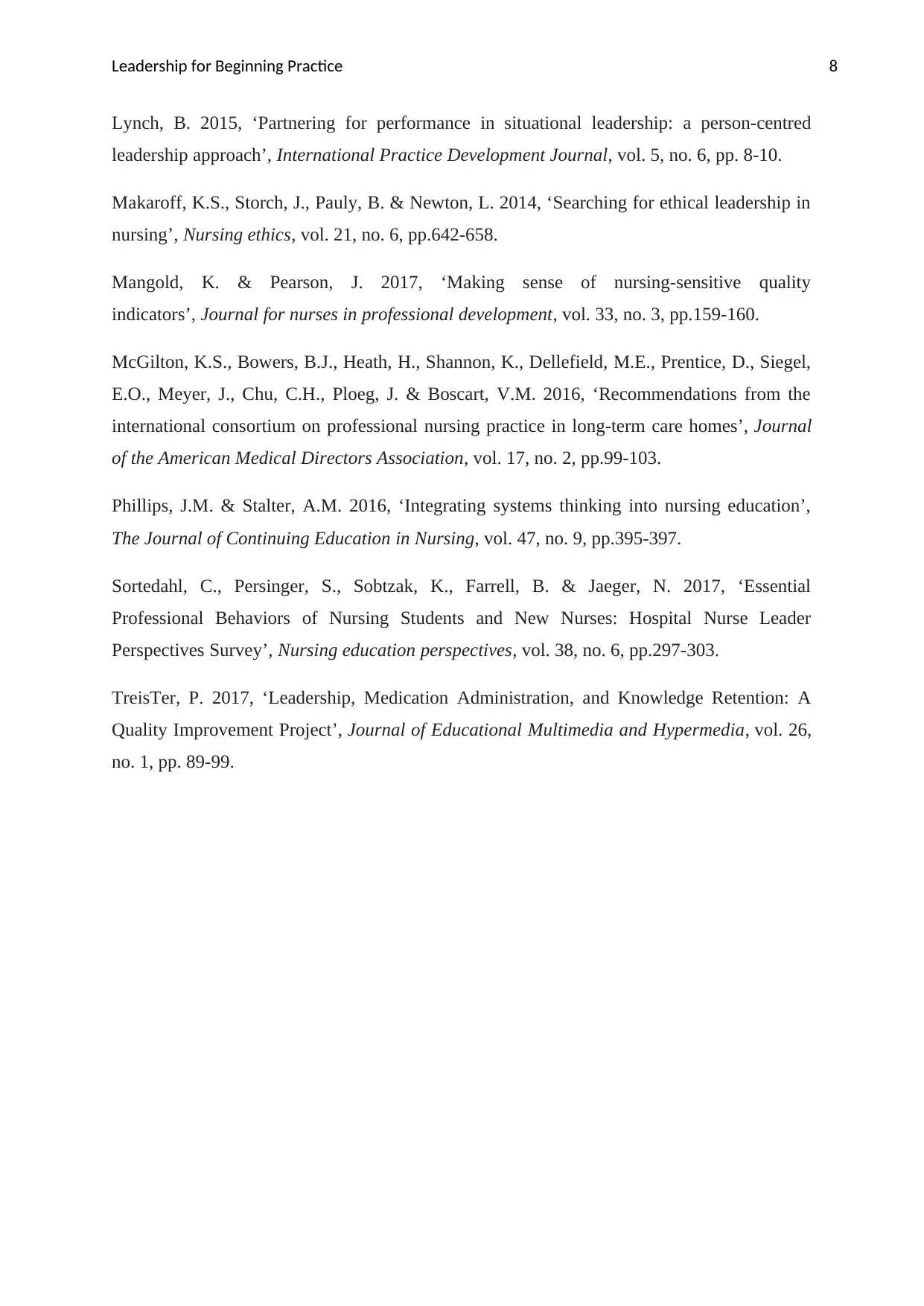
Leadership for Beginning Practice 8
Lynch, B. 2015, ‘Partnering for performance in situational leadership: a person-centred
leadership approach’, International Practice Development Journal, vol. 5, no. 6, pp. 8-10.
Makaroff, K.S., Storch, J., Pauly, B. & Newton, L. 2014, ‘Searching for ethical leadership in
nursing’, Nursing ethics, vol. 21, no. 6, pp.642-658.
Mangold, K. & Pearson, J. 2017, ‘Making sense of nursing-sensitive quality
indicators’, Journal for nurses in professional development, vol. 33, no. 3, pp.159-160.
McGilton, K.S., Bowers, B.J., Heath, H., Shannon, K., Dellefield, M.E., Prentice, D., Siegel,
E.O., Meyer, J., Chu, C.H., Ploeg, J. & Boscart, V.M. 2016, ‘Recommendations from the
international consortium on professional nursing practice in long-term care homes’, Journal
of the American Medical Directors Association, vol. 17, no. 2, pp.99-103.
Phillips, J.M. & Stalter, A.M. 2016, ‘Integrating systems thinking into nursing education’,
The Journal of Continuing Education in Nursing, vol. 47, no. 9, pp.395-397.
Sortedahl, C., Persinger, S., Sobtzak, K., Farrell, B. & Jaeger, N. 2017, ‘Essential
Professional Behaviors of Nursing Students and New Nurses: Hospital Nurse Leader
Perspectives Survey’, Nursing education perspectives, vol. 38, no. 6, pp.297-303.
TreisTer, P. 2017, ‘Leadership, Medication Administration, and Knowledge Retention: A
Quality Improvement Project’, Journal of Educational Multimedia and Hypermedia, vol. 26,
no. 1, pp. 89-99.
Lynch, B. 2015, ‘Partnering for performance in situational leadership: a person-centred
leadership approach’, International Practice Development Journal, vol. 5, no. 6, pp. 8-10.
Makaroff, K.S., Storch, J., Pauly, B. & Newton, L. 2014, ‘Searching for ethical leadership in
nursing’, Nursing ethics, vol. 21, no. 6, pp.642-658.
Mangold, K. & Pearson, J. 2017, ‘Making sense of nursing-sensitive quality
indicators’, Journal for nurses in professional development, vol. 33, no. 3, pp.159-160.
McGilton, K.S., Bowers, B.J., Heath, H., Shannon, K., Dellefield, M.E., Prentice, D., Siegel,
E.O., Meyer, J., Chu, C.H., Ploeg, J. & Boscart, V.M. 2016, ‘Recommendations from the
international consortium on professional nursing practice in long-term care homes’, Journal
of the American Medical Directors Association, vol. 17, no. 2, pp.99-103.
Phillips, J.M. & Stalter, A.M. 2016, ‘Integrating systems thinking into nursing education’,
The Journal of Continuing Education in Nursing, vol. 47, no. 9, pp.395-397.
Sortedahl, C., Persinger, S., Sobtzak, K., Farrell, B. & Jaeger, N. 2017, ‘Essential
Professional Behaviors of Nursing Students and New Nurses: Hospital Nurse Leader
Perspectives Survey’, Nursing education perspectives, vol. 38, no. 6, pp.297-303.
TreisTer, P. 2017, ‘Leadership, Medication Administration, and Knowledge Retention: A
Quality Improvement Project’, Journal of Educational Multimedia and Hypermedia, vol. 26,
no. 1, pp. 89-99.
⊘ This is a preview!⊘
Do you want full access?
Subscribe today to unlock all pages.

Trusted by 1+ million students worldwide
1 out of 9
Related Documents
Your All-in-One AI-Powered Toolkit for Academic Success.
+13062052269
info@desklib.com
Available 24*7 on WhatsApp / Email
![[object Object]](/_next/static/media/star-bottom.7253800d.svg)
Unlock your academic potential
Copyright © 2020–2025 A2Z Services. All Rights Reserved. Developed and managed by ZUCOL.





